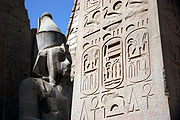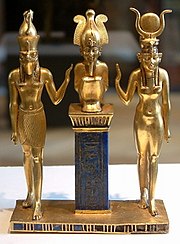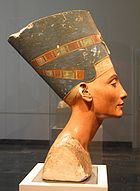Portal:Ancient Egypt/Selected article
Selected article 1
Portal:Ancient Egypt/Selected article/1

Ancient Egyptian literature is literature written in the Egyptian language from Ancient Egypt's pharaonic period until the end of Roman domination. It represents the oldest corpus of Egyptian literature. Along with Sumerian literature, it is considered the world's earliest literature.
It is possible that the overall literacy rate was less than one percent of the entire population. The creation of literature was thus an elite exercise, monopolized by a scribal class attached to government offices and the royal court of the ruling pharaoh. However, there is no full consensus among modern scholars concerning the dependence of ancient Egyptian literature on the sociopolitical order of the royal court. Ancient Egyptian literature has been preserved on a wide variety of media. This includes papyrus scrolls and packets, limestone or ceramic ostraca, wooden writing boards, monumental stone edifices, and even coffins. Texts preserved and unearthed by modern archaeologists represent a small fraction of ancient Egyptian literary material. The area of the floodplain of the Nile is under-represented because the moist environment is unsuitable for the preservation of papyri and ink 0inscriptions. On the other hand, hidden caches of literature, buried for hundreads of years, have been discovered in settlements on the dry desert margins of Egypt. Read more...
Selected article 2
Portal:Ancient Egypt/Selected article/2

Ancient Egypt's success stemmed partly from its ability to adapt to the conditions of the Nile River Valley. The predictable flooding and controlled irrigation of the fertile valley produced surplus crops, which fueled social development and culture. With resources to spare, the administration sponsored mineral exploitation of the valley and surrounding desert regions, the early development of an independent writing system, the organization of collective construction and agricultural projects, trade with surrounding regions, and a military intended to defeat foreign enemies and assert Egyptian dominance. Motivating and organizing these activities was a bureaucracy of elite scribes, religious leaders, and administrators under the control of a pharaoh who ensured the cooperation and unity of the Egyptian people in the context of an elaborate system of religious beliefs.
The many achievements of the ancient Egyptians include the quarrying, surveying and construction techniques that facilitated the building of monumental pyramids, temples, and obelisks; a system of mathematics, a practical and effective system of medicine, irrigation systems and agricultural production techniques, the first known ships, Egyptian faience and glass technology, new forms of literature, and the earliest known peace treaty. Its art and architecture were widely copied, and its antiquities carried off to far corners of the world. Its monumental ruins have inspired the imaginations of travellers and writers for centuries.
Selected article 3
Portal:Ancient Egypt/Selected article/3

Thinis or This (Egyptian: Tjenu) was a city, as yet undiscovered, which the classical historian Manetho cites as the centre of the Thinite Confederacy, a tribal confederation whose leader, Menes (or Narmer), united Egypt and was its first pharaoh, and as the capital of the first dynasties of ancient Egypt. The precise location of Thinis is unknown, although mainstream Egyptological consensus places it in the vicinity of ancient Abydos and modern Girga.
Other proprosals for Thinis' location have lost favour at the expense of the Girga-Birba theory: Auguste Mariette, founder director of the Egyptian Museum, suggested Kom el-Sultan; A. Schmidt, El-Kherbeh; and Heinrich Karl Brugsch, Johannes Dümichen and others supported El-Tineh, near Berdis. Mainstream Egyptological consensus continues to locate Thinis at or near to either Girga or El-Birba, where an inscribed statue fragment mentioning Thinis is said to have been found. Although the archaeological site of Thinis has never been located, evidence of population concentration in the Abydos-Thinis region dates from the fourth millennium BCE. Thinis is also cited as the earliest royal burial-site in Egypt.
Selected article 4
Portal:Ancient Egypt/Selected article/4

The Valley of the Kings is a valley in Egypt where, for a period of nearly 500 years from the 16th to 11th century BC, tombs were constructed for the Pharaohs and powerful nobles of the New Kingdom (the Eighteenth to the Twentieth Dynasties of Ancient Egypt). The valley stands on the west bank of the Nile, opposite Thebes (modern Luxor), within the heart of the Theban Necropolis. The wadi consists of two valleys, East Valley (where the majority of the royal tombs situated) and West Valley.
The area has been a focus of archaeological and egyptological exploration since the end of the eighteenth century, and its tombs and burials continue to stimulate research and interest. In modern times the valley has become famous for the discovery of the tomb of Tutankhamun, and is one of the most famous archaeological sites in the world. In 1979, it became a World Heritage Site, along with the rest of the Theban Necropolis. Exploration, excavation and conservation continues in the valley, and a new tourist centre has recently been opened.
Selected article 5
Portal:Ancient Egypt/Selected article/5
The Nefertiti Bust is a 3300-year-old painted limestone bust of Nefertiti, the Great Royal Wife of the Egyptian Pharaoh Akhenaten and is one of the most copied works of ancient Egypt. Due to the bust, Nefertiti has become one of the most famous women from the ancient world as well as an icon of female beauty. It is believed to have been crafted in 1345 BC by the sculptor Thutmose.
A German archeological team led by Ludwig Borchardt discovered the Nefertiti bust in 1912 in Thutmose's workshop in Amarna, Egypt. It has been kept at several locations in Germany since its discovery, including a salt mine in Merkers-Kieselbach, the Dahlem museum (then in West Berlin), the Egyptian Museum in Charlottenburg and the Altes Museum. It is currently on display at the Neues Museum, Berlin, where it was displayed before World War II.
The Nefertiti bust has become a cultural symbol of Berlin, Germany as well as of ancient Egypt. It has also been the subject of an intense argument between Egypt and Germany over the Egyptian demands for its repatriation. It was dragged into controversies over the Body of Nerfertiti art exhibition and also by allegations regarding its authenticity.
Selected article 6
Portal:Ancient Egypt/Selected article/6

The city of Gaza has a history of habitation that dates back 5,000 years, making it one of the oldest cities in the world. Located on the Mediterranean coastal route between North Africa and the Levant, for most of its history it served as a key entrepot of southern Palestine and an important stopover on the spice trade route traversing the Red Sea.
Settlement in the region of Gaza dates back to Tell as-Sakan, an Ancient Egyptian fortress built in Canaanite territory to the south of present-day Gaza. The site went into decline throughout the Early Bronze Age II as its trade with Egypt sharply decreased. Gaza later served as Egypt's administrative capital in Canaan. During the reign of Thutmose III, the city became a stop on the Syrian-Egyptian caravan route and was mentioned in the Amarna letters as "Azzati". Gaza remained under Egyptian control for 350 years until it was conquered by the Philistines in the 12th century BCE, becoming a part of their "pentapolis". According to the Book of Judges, Gaza was the place where Samson was imprisoned by the Philistines and met his death. After being ruled by the Israelites, Assyrians, and then the Egyptians, Gaza achieved relative independence and prosperity under the Persian Empire. Alexander the Great besieged Gaza, the last city to resist his conquest on his path to Egypt, for five months before finally capturing it 332 BCE.
Selected article 7
Portal:Ancient Egypt/Selected article/7

Sirius is the brightest star in the night sky. With a visual apparent magnitude of −1.46, it is almost twice as bright as Canopus, the next brightest star. Known in Ancient Egypt as Sopdet, it is recorded in the earliest astronomical records. During the era of the Middle Kingdom, Egyptians based their calendar on the heliacal rising of Sirius, namely the day it becomes visible just before sunrise after moving far enough away from the glare of the Sun. This occurred just before the annual flooding of the Nile and the summer solstice, after a 70-day absence from the skies.
The hieroglyph for Sothis features a star and a triangle. Sothis was identified with the great goddess Isis, who formed a part of a trinity with her husband Osiris and their son Horus, while the 70-day period symbolised the passing of Isis and Osiris through the duat (Egyptian underworld). Ptolemy of Alexandria mapped the stars in Book VII and VIII of his Almagest, in which he used Sirius as the location for the globe's central meridian. He curiously depicted it as one of six red-coloured stars
Selected article 8
Portal:Ancient Egypt/Selected article/8

The Kingdom of Makuria was a kingdom located in what is today Northern Sudan and Southern Egypt. It was one of a group of Nubian kingdoms that emerged during the decline of the Aksumite Empire, of which it had been part. Makuria originally covered the area along the Nile River from the Third Cataract to somewhere between the Fifth and Sixth Cataracts. It also had control over the trade routes, mines, and oases to the east and west. Its capital was Dongola and the kingdom is sometimes known by the name of its capital. Makuria is much better known than its neighbor Alodia to the south, but there are still many gaps in our knowledge. The origins of Makuria are uncertain. Ptolemy mentions a Nubian people known as the Makkourae, who might be ancestors to the Makurians.[1] The kingdom is believed to have formed in the 4th or 5th century.
One of the most debated issues among scholars is over the religion of Makuria. Up to the fifth century the old Egyptian mythology seems to have remained strong, even while its counterpart in Egypt disappeared. In the fifth century the Nubians went so far as to launch an invasion of Egypt when the Christians there tried to turn some of the main temples into churches.
Selected article 9
Portal:Ancient Egypt/Selected article/9

The Rosetta Stone is a fragment of an Ancient Egyptian granodiorite stele, the engraved text of which provided the key to the modern understanding of Egyptian hieroglyphs. The inscription records a decree that was issued at Memphis in 196 BC on behalf of King Ptolemy V. The decree appears in three texts: the upper one is in ancient Egyptian hieroglyphs, the middle one in Egyptian demotic script, and the lower text in ancient Greek.
Originally displayed within a temple, the stele was probably moved during the early Christian or medieval period, and eventually used as building material in the construction of a fort at the town of Rashid (Rosetta) in the Nile Delta. It was rediscovered there in 1799 by a soldier of the French expedition to Egypt. As the first ancient bilingual text recovered in modern times, the Rosetta Stone was the essential key to modern understanding of ancient Egyptian literature and civilization. The decipherment of the Egyptian texts was announced by Jean-François Champollion in Paris in 1822. Today, it is the most-visited object in the British Museum.
Selected article 10
Portal:Ancient Egypt/Selected article/10

The Gebelein predynastic mummies are six naturally mummified bodies, dating to approximately 3400 BC from the Late Predynastic period of Egypt and were the first complete pre-dynastic bodies to be discovered. The well-preserved bodies were excavated at the end of the nineteenth century by Wallis Budge, the British Museum Keeper for Egyptology, from shallow sand graves near Gebelein in the Egyptian desert. Budge excavated all the bodies from the same grave site. Two were identified as male, one female with the others being of undetermined gender. The bodies were given to the British Museum in 1900. Some grave-goods were documented at the time of excavation as "pots and flints", however they were not passed on to the British Museum and their whereabouts remain unknown. Three of the bodies were found with coverings of different types (reed matting, palm fibre and an animal skin), which still remain with the bodies. The bodies were found in foetal positions lying on their left side. From 1901 the first body excavated has remained on display in the British Museum.
Selected article 11
Portal:Ancient Egypt/Selected article/11

The Louvre Museum is one of the world's largest museums, the most visited art museum in the world, and a historic monument. The Egyptian antiquities department, comprising over 50,000 pieces, includes artifacts from the Nile civilizations which date from 4,000 BC to the 4th century AD. The collection, among the world's largest, overviews Egyptian life spanning ancient Egypt, the Middle Kingdom, the New Kingdom, Coptic art, and the Roman, Ptolemaic, and Byzantine periods. The department's origins lie in the royal collection, but it was augmented by Napoleon's 1798 expeditionary trip with Dominique Vivant, the future director of the Louvre. After Jean-François Champollion translated the Rosetta Stone, Charles X decreed that an Egyptian Antiquities department be created. Champollion advised the purchase of three collections, the Durand, Salt and Drovetti; these additions added 7,000 works. Growth continued via acquisitions by Auguste Mariette, founder of the Egyptian Museum in Cairo. Mariette, after excavations at Memphis, sent back crates of archaeological finds including The Seated Scribe.


